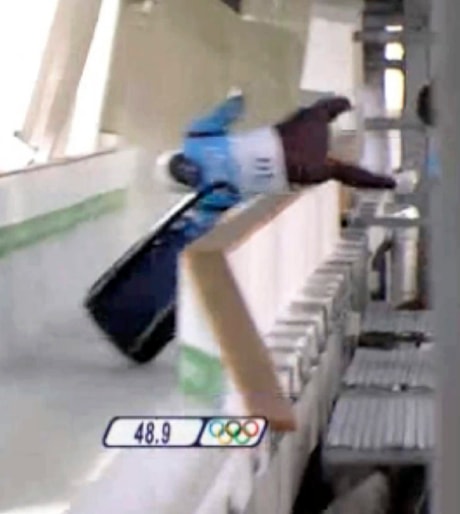WHISTLER, B.C. — Georgian luger Nodar Kumaritashvili has died in a horrific Olympic training run on the eve of the Games opening, flying off a high-speed track that has wasted little time showing its teeth.
The 21-year-old lost control of his sled near the finish Friday, went over the track wall and rocketed into a support pole near the finish line at the Whistler Sliding Centre.
The Georgian was coming around the final 270-degree turn on the lightning-fast course, where top sliders have exceeded 145 km/h, when he flipped off his sled and was hurled like a missile into one of the thick metal pillars that supports the canopy above the finish area.
The slider, a blur in his black-and-blue racing suit and white helmet went high in the corner, banking left. His sled swooped out from under him, hit the inside wall and the Georgian flew through the air, turning backwards as he launched into the square support stanchion lining the outside of the track.
There was a collective gasp on the finish dock from officials and athletes as the crash was beamed on the large-screen TVs.
The screens were immediately turned off as crews raced down the track to the stricken racer.
The track is considered the fastest in the world. For some athletes, it’s too fast.
The luge competition was scheduled to begin Saturday. There was no immediate word if the men’s singles event would be postponed.
Kumaritashvili, a relatively inexperienced luger, had competed in five World Cup races this season, finishing 44th in the world standings.
It was Kumaritashvili’s second crash during training for the Vancouver Games. He also failed to finish his second of six practice runs.
The shocking crash cast a pall on the Games, which had been gearing up for a worldwide opening ceremony celebration to be beamed live from B.C. Place. Instead top officials found themselves offering condolences.
In a statement, the IOC confirmed the death “with great regret,” saying “doctors were unable to revive the athlete, who died in hospital.”
“Our first thoughts are with the family, friends and colleagues of the athlete. The whole Olympic family is struck by this tragedy which clearly casts a shadow over these Games,” said International Olympic Committee president Jacques Rogge.
Added VANOC CEO John Furlong: “We are deeply struck by this tragedy and join the IOC in extending our condolences to the family, friends and teammates of the athlete, who came to Vancouver to follow his Olympic dream.”
VANOC officials issued a release saying an investigation was taking place to “ensure a safe field of play.” Training was cancelled and members of the International Luge Federation were called for a briefing with team captains from each nation asked to attend a meeting.
“This is a terrible accident,” said Josef Fendt, president of the International Luge Federation. “This is the very gravest thing that can happen in sport, and our thoughts and those of the luge family, are naturally with those touched by this event.”
Medics were seen performing mouth to mouth on the Georgian, his helmet still on, face up on the cement beside the track and the ambulance. Track officials then ordered all bystanders away.
Medics administered CPR to a bloodied Kumaritashvili before he was lifted into an ambulance. An air-rescue helicopter arrived some eight minutes after the crash. The slider was taken to a medical facility at the athletes village south of Whistler.
Video of the crash was soon posted on YouTube — and pulled down for TV rights violation.
At the finish area, not far from the crash, athletes, coaches and officials awaited word on Kumaritashvili. Then they heard the worst.
“This is the first time we’ve seen this. It’s very sad,” said Canadian luge team coach Wolfgang Staudinger, adding he planned to meet with his team to discuss what happened.
The $105-million sliding centre, on the southeast face of Blackcomb Mountain, has been billed as a wild ride and the accident happened at its fastest point.
The 1,450-metre course has 16 turns and drops steeply for 152 metres, the longest drop of any track in the world.
The average grade is about 11 per cent, including two stomach-inverting drops of 20 per cent.
More than a dozen athletes have crashed during Olympic training, with a Romanian woman briefly knocked unconscious.
Defending Olympic champion Armin Zoeggeler of Italy lost control on the lower part of the track Friday. He didn’t appear to be injured. On Thursday, Romanian women’s slider Violeta Stramaturaru crashed and had to be airlifted out.
“I think they are pushing it a little too much,” Australia’s Hannah Campbell-Pegg said Thursday night after she nearly lost control in training. “To what extent are we just little lemmings that they just throw down a track and we’re crash-test dummies? I mean, this is our lives.”
American slider Bengt Walden also crashed in training.
“You’re trying to let the sled run more and that’s when mistakes happen,” said Walden.. “Once you think you’ve got it figured out and you’re being calm, that’s when things like this happen.”
Added Walden: “I don’t think they’re going to build more faster tracks than this. I think the (governing body) FIL was almost unhappy with how fast the track turned out to be.”
The Georgian’s crash happened midway through the sixth and final training run.
